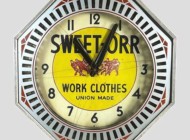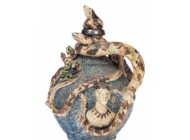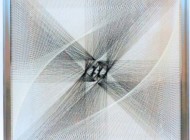
Fritz Scholder’s art threw out the traditional, stereotypical images of the mythic Native with drawings and prints that feature bold, expressive lines, vibrant colors and potent imagery. This untitled (Chief) acrylic on paper, commanded $13,530, nearly double its $5/7,000 presale estimate.
Review by W.A. Demers
SANTA FE, N.M. — Two days of an annual auction extravaganza celebrated the Native American art market at Santa Fe Art Auction on August 13-14, timed to coincide with Santa Fe’s Indian Market, which features hundreds of artists showcasing a variety of art forms and taking up some 12 city blocks. Up for bidding at Santa Fe Art Auction were nearly 500 lots offering a wide selection for Native arts collectors, everything from traditional rugs and blankets, vintage jewelry, pottery from each of the great pueblos, basketry, Plains hide and beadwork, as well as sculpture and paintings from early Indian School to Twenty-First Century contemporary. This last category led the offerings as Fritz Scholder’s (Luiseño, 1937-2005) untitled (Chief), acrylic on paper, jumped its $5/7,000 presale estimate to command $13,530. According to Scholder’s official website (www.fritzscholder.com), his art broke all the conventions in redefining the representation of the “American Indian” in American art, throwing out the traditional, stereotypical images of the mythic Native with drawings and prints that feature bold, expressive lines, vibrant colors and potent imagery.
His work is included in the collections of more than 120 museums in the United States, including the National Museum of American Art in Washington, the Museum of Modern Art in New York and the Metropolitan Museum of Art in New York.

Pottery owls also did very well. This lot of six Acoma/Zuni fired clay birds, circa 1940-75, made $2,768.
Totaling $593,000 and with a sell-through rate of 95 percent, the two-day sale delivered high marks for fine art, basketry, pottery, wearable textiles and a charming parliament of pottery owls (parliament being the collective term as ancient Greeks deemed owls to be very wise birds). As for the number of registered bidders, Gillian Blitch, the firm’s president and chief executive officer said, “It’s a difficult number to arrive at. They [the platforms] pre-register people, so the minute I open a sale up I already have 3,000 ‘registered’ bidders. We had 5,000 just on Invaluable. Over a quarter of a million alerts went out and that’s just on Invaluable. More than 35 countries.” The number of invoices the auction house sent out was 225. Also, with folks in town for the Indian Market — both dealers and collectors — Blitch added, “We were very busy for the 10 days we had the exhibit up. Two showrooms and a huge number of visitors.”
A Western Apache basketry olla, made around 1915, surpassed its $5/7,000 estimate to finish at $12,300. According to the US Department of the Interior, the Western Apache — Cibecue, San Carlos, White Mountain and Northern and Southern Tonto — made many kinds of baskets, the largest of which was called an olla. This one, with a willow rod foundation and willow and martynia weft, was 27 inches high by 27 inches in diameter. These baskets were handcrafted for water storage and to hold seed and corn. It was determined that this large example was made for the trade, not for storage.
An untitled oil on canvas by Margarete Bagshaw (1964-2015) performed well, rising from its $3/5,000 estimate to leave the gallery at $9,840. An American artist whose paintings and pottery were Modernist in style, Bagshaw emerged in her right, having grown up the daughter and granddaughter of noted Native artists. “She’s from that remarkable dynasty, right?” Blitch observed. “From Pablita (Velarde) through Helen (Hardin) and then Margarete. Helen was a breakout artist, one of the earliest to break out of Dorothy Dunn’s Indian school painting to do something more abstracted and contemporary in their own mythology. And her daughter Margarete, as you can see, went much more abstracted than that.” This painting measured 23½ by 49-5/8 inches.

This colorful 1997 acrylic on linen by Cherokee artist Dolona Roberts, “Council Time,” agreed to exceed its $1,5/2,500 estimate to attain $8,610.
Another Fritz Scholder work, a monotype titled “Bunch of Flowers #2,” more than doubled its high estimate to take $9,840. The 41-by-31-inch work came from a private New York collection. “He [Scholder] did work with flowers,” explained Blitch. “He famously did a series with roses and tulips. And he loved the art of printmaking. He really enjoyed it. I think when you know his work, it’s not that atypical.”
“Council Time” by Dolona Roberts (Cherokee, b 1936) depicted three figures dressed in colorful wearing blankets with their backs to the viewer. “We had several pieces by Dolona, and this one was particularly beautiful,” Blitch remarked. The 1997 acrylic on linen vaulted from its $1,5/2,500 estimate to a final price of $8,610.
“Ghost Rider,” John Nieto’s (1936-2018) luminescent green rider and horse figures in an acrylic on canvas from 2001, saw $3,690, beating its $1,5/2,500 estimate. “Strong and steady. We have several major works of his coming up in November,” said Blitch. “He’s from that period where the color was important, the representation of the Native American in a different context that still told their story. His work continues to be very desirable.”
Fetching $6,765, twice its high estimate, was a Dine (Navajo) blanket, circa 1885. Woven with natural fibers and colored with indigo and aniline dyes, it measured 57-3/8 by 69½ inches.
And this auction review would be remiss not to include the sale’s pottery owls, as these also did very well. The first lot — six pottery owls by various artists circa 1940-75 — sold for $2,768. “Remarkably,” according to Blitch, others, in lots of six, seven and eight, sold between $2,460 and $3,383. “They were all from the same collection and, though the auction house broke them up into groupings, they all sold together to another collector. They’ve always been a major collecting area here.”
The Zuni culture holds that the owl, known as the “Night Grandfather,” stands for wisdom, truth and the protection of the home. Wonder how many successful bidders have placed them where they can use their powers of observance, perception and their ability to see things that others cannot.
Prices given include the buyer’s premium as stated by the auction house. The next sale, featuring contemporary art and photography, is set for September 18. Following that will be the Signature sale on November 8-9. For additional information, 505-954-5858 or www.santafeartauction.com.












